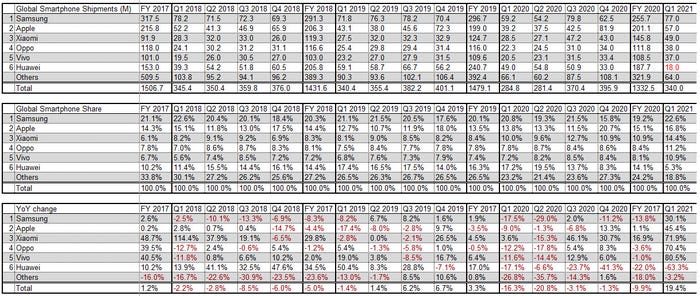Global smartphone shipments jump 24% in Q1 2021
Strategy Analytics was the first out of the blocks with its global smartphone numbers this quarter and it reveals a significant rebound from last year’s challenges.
April 20, 2021

Strategy Analytics was the first out of the blocks with its global smartphone numbers this quarter and it reveals a significant rebound from last year’s challenges.
340 million smartphone units were shipped worldwide in Q1 2021, which is around the historical average for that quarter but a 24% increase on SA’s numbers for the year-ago one. While the global pandemic didn’t really kick in until March of last year, it had been rampant in China since the start of the year, if not before, and massive manufacturers such as Foxconn had suspended production. These latest numbers indicate a return to normal for the smartphone market at least.
“The China smartphone market had a sensational quarter driven by 5G product success across multiple price tiers,” said SA’s Linda Sui. “China smartphone shipments were up +35% YoY reaching 94 million units in Q1 2021.
“Globally, the top five vendors combined took a 76% market share in Q1 2021, up from 71% one year ago. Chip shortages and supply side constraints did not have a significant impact in Q1 among the top 5 brands but was and will be a concern for smaller vendors over the next few quarters in our view.”
For some reason SA has decided to gloss over the Huawei situation, not only avoiding mention of it in the above quotes, but excluding it from its numbers too. So, combining the SA’s market sizing with Counterpoint’s China vendor share numbers and chucking in a few million for the rest of the world (which could be generous) to arrive at the number below. Note we probably used another source of numbers a year ago, hence total market growth of just 19.4% in the table.
It’s also worth noting that SA has decided to round its public numbers off, thus reducing their accuracy. Lastly it seems the smartphone world is consolidating around the top five vendors, three of which are Chinese, judging by the significant decline in the ‘others’ share. Xiaomi and Oppo have expanded globally, but Vivo still seems to be dependent on its domestic market. It wouldn’t be surprising to see it move to change that soon.

About the Author
You May Also Like


.png?width=300&auto=webp&quality=80&disable=upscale)







.png?width=300&auto=webp&quality=80&disable=upscale)


_1.jpg?width=300&auto=webp&quality=80&disable=upscale)